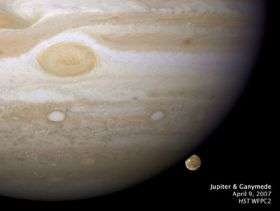Scientists Make Image, Movie of a Jupiter Moon Setting

(PhysOrg.com) -- Jupiter's largest moon, Ganymede, is seen just before it slips behind its giant planet in a new color image and a movie made by a University of Arizona scientist from images taken by NASA's Hubble Space Telescope.
Erich Karkoschka of the UA's Lunar and Planetary Laboratory made the color image from three images taken by Hubble's Wide Field Planetary Camera 2 in red, green and blue filters on April 9, 2007. The image shows Jupiter and Ganymede in close to natural colors.
Karkoschka's 18-second movie shows Ganymede ducking behind Jupiter. Hubble's wide-field camera took 14 images over a 40-minute period on April 9, 2007. Karkoschka used these images to create 540 image frames based on 2-hour observations of Jupiter's and Ganymede's motions.
Ganymede completes an orbit around Jupiter every seven days. Because Ganymede's orbit is tilted nearly edge-on to Earth, it routinely can be seen passing in front of and disappearing behind Jupiter, then reemerging later, like a kind of "peek-a-boo" game.
"Images like this one are useful in studying Jupiter's upper atmosphere," Karkoschka said.
"Thousands of Jupiter images have been taken from Earth and space, from far and close, but they all look 'down' on Jupiter," Karkoschka said. "By contrast, these observations looked at grazing geometry all the way down through the atmosphere.
"As Ganymede passes behind the planet, it reflects sunlight, which then passes through Jupiter's upper atmosphere. Information on the planet's atmosphere becomes imprinted on this light," Karkoschka said. "Observations made with ultraviolet and near-infrared filters were a hundred times more sensitive to tiny amounts of hazes and extended to altitudes 100 kilometers (60 miles) higher than Jupiter's clouds."
Composed of rock and ice, Ganymede is the largest moon in our solar system. It is even larger than the planet Mercury. But Ganymede looks like a dirty snowball next to Jupiter, the largest planet in our solar system. Jupiter is so vast that only part of its southern hemisphere can be seen in the new image.
Hubble's view is so sharp that astronomers can see features on Ganymede's surface. Prominent is a white impact crater called "Tros" and its system of rays, bright streaks of material blasted from the crater. Tros and its ray system are roughly the width of Arizona.
The image also shows Jupiter's Great Red Spot, a large eye-shaped feature seen in the upper left part of the image. The Great Red Spot is a storm the size of two Earths, and it has been raging for more than 300 years. The image is so sharp it also reveals the texture of the clouds in Jupiter's atmosphere, as well as other storms and vortices.
The Space Telescope Science Institute in Baltimore, Md., the center for Hubble operations, released the image and the movie today.
Provided by University of Arizona





















